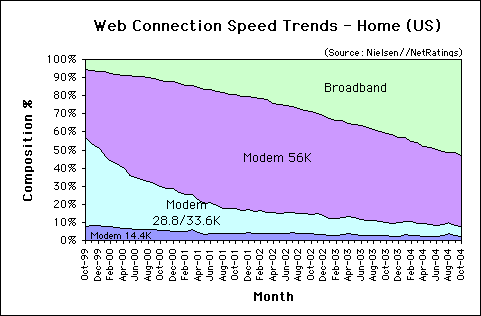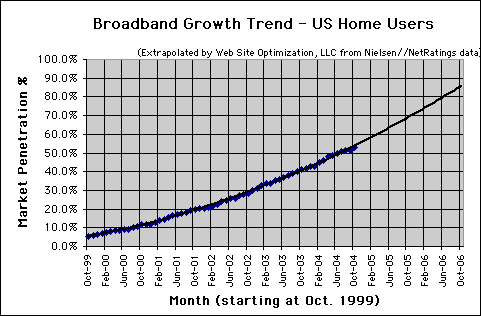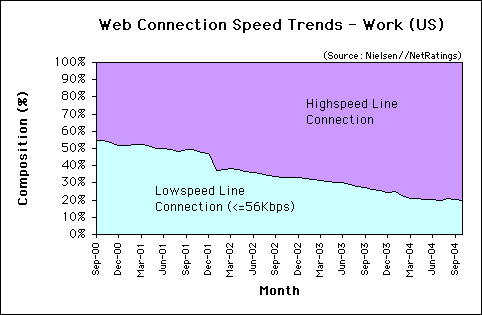U.S. broadband penetration grew by 1.53 percentage points to 52.86% among active Internet users in October. 47.14% of US home users dial into the Internet with “narrowband” connections of 56Kbps or less. NASA has begun work on a laser-based interplanetary broadband link to transmit data back from Mars.
The charts below, derived from Nielsen//NetRatings data, show trends in connection speeds to the Internet for United States users.*
Home Connectivity in the US
In October 2004, most active Internet users connect from home with broadband connections. Among narrowband users, 39.54% use 56Kbps modems, 5.2% use 28/33.3Kbps, and 2.4% use 14.4Kbps modems. In total, 47.14% of home users in the US connect to the Internet at 56Kbps or less (see Figure 1).
Web Connection Speed Trends – Home Users (US)
Figure 1: Web Connection Speed Trends – Home Users (US)
Source: Nielsen//NetRatings
Broadband Growth in the US
Broadband penetration in the US grew by 1.53 points to 52.86% in October, up from 51.33% in September. This increase is greater than the average increase in broadband of 1.04 points per month over the previous twelve months. Broadband share in the US should exceed 70% by November of 2005 (see Figure 2).
Broadband Connection Speed Trend – Home Users (US)
Figure 2: Broadband Connection Speed Trend – Home Users (US)
Extrapolated from Nielsen//NetRatings data
Work Connectivity
Most workers in the US enjoy high-speed connections to the Internet. Most use a high-speed line such as a T1 connection, and share bandwidth between computers connected to an Ethernet network. The speed of each connection decreases as more employees hook up to the LAN. As of October of 2004, of those connected to the Internet, 80.33% of US users at work enjoy a high-speed connection, up 0.7% percentage points from 79.63% in September. At work, 19.67% connect at 56Kbps or less (see Figure 3).
Web Connection Speed Trends – Work Users (US)
Figure 3: Web Connection Speed Trends – Work Users (US)
Source: Nielsen//NetRatings
Interplanetary Broadband Laser
NASA has begin work on an interplanetary laser communication link to transmit data from planetary probes. If successful, the $300 million experiment would beam data up to 30 billion bits per second under optimal conditions. NASA plans to test the 5-watt laser at Mars by the end of the decade.
Further Reading
- Aussie kids are broadband kids
- Australians are rapidly opting for broadband access from home, with 41% of all home Internet users on broadband. Australia has overtaken Sweden in broadband penetration, and some predict that Australia will overtake the United States within nine months. Sydney Morning Herald, Nov. 18, 2004.
- Broadband Internet Rebounds With Record Quarter
- A record 2.3 million people subscribed to broadband in the third quarter of 2004. Comcast, Time Warner, and Cox lead cable broadband providers with cable garnering 61% of the broadband market. SBC, Verizon, and Bell South top DSL providers in the US. Leichtman Research, Nov. 10, 2004.
- NASA To Test Laser Communications With Mars Spacecraft
- “Work is underway to establish the first interplanetary laser communication link. The $300 million NASA experiment, if successful, will connect robotic spacecraft at Mars with scientists back on Earth via a beam of light traveling some 300 million kilometers.” Space.com, Nov. 15, 2004.
- Nielsen//NetRatings
- Provides the US broadband data (percentage of active Internet users) for the Bandwidth Report.
- Race is on to plug in high-speed Net links
- “The next two years could bring nothing short of an broadband arms race, as cable TV and Baby Bell phone companies joust to furnish your home’s every communication and entertainment need.” The FCC’s ruling last month freeing companies from sharing high-speed networks has spawned a slew of announcements by SBC and the Baby Bells. By Scott Anderson, The Ann Arbor News, Nov. 14, 2004.
*Note that Nielsen//NetRatings reports the percentage of active Internet users that use broadband from home, not broadband households. NetRatings uses a panel of 40,000 to 50,000 people with software meters installed on their computers. These meters detect connection speeds. Each month they do an enumeration study to call a number of people to calibrate the panel by adjusting weightings to match the population at large.
The Bandwidth Report is featured monthly on URLwire – news of useful and unique web content since 1994.



